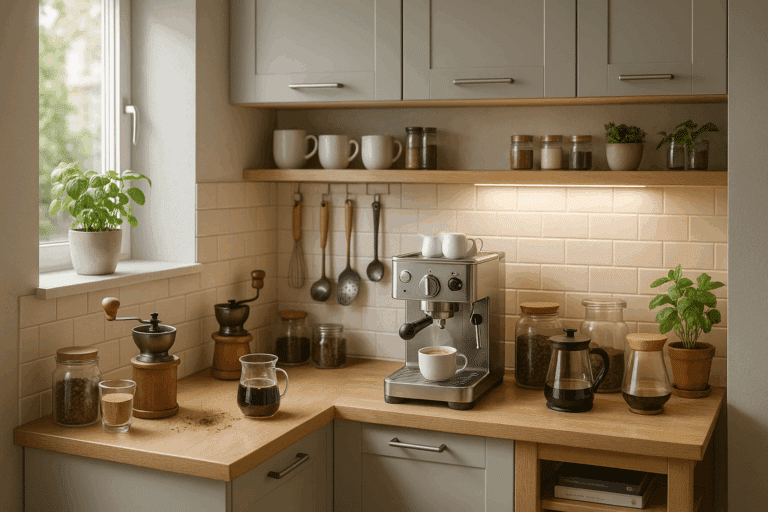Coffee, a staple in many of our routines, is not just a beverage; it’s an art. The art of brewing a perfect cup is a journey that involves precision, knowledge, and passion. Pour-over coffee, a method loved by coffee aficionados worldwide, is no exception. It gives you full control over the brewing process, and the results, when done right, are unparalleled. 🙌
Are you a coffee connoisseur, or just someone who appreciates a good cup of coffee and is willing to take your brewing game to the next level? Then, you’ve landed in the right place. In this article, we will delve into the world of pour-over coffee, explaining how you can master this art and even build your own DIY stand to add a personal touch to your coffee making ritual. So, brace yourself for an enlightening caffeine-infused read! ☕
Understanding Pour-Over Coffee
Before we plunge into the specifics, let’s take a brief look at what pour-over coffee is and why it stands out. Pour-over coffee is a brewing method where hot water is poured over ground coffee in a filter. The water then slowly drips through the coffee grounds, extracting flavors along the way, and ends up in your cup. It might sound simple, but the subtleties involved in the process make a world of difference in your cup’s final outcome.🌍
Why a DIY Stand?
Now, you might wonder, why go through the trouble of building a DIY stand for pour-over coffee? Couldn’t you just use a ready-made stand or even brew without one? Technically, yes. But where’s the fun in that? A DIY stand not only gives you a sense of accomplishment but also allows you to customize it to your specific needs. And let’s not forget the aesthetic appeal that a bespoke stand adds to your coffee station! 🎨
What Awaits You in This Article
Now that you have a general idea of what pour-over coffee is and why a DIY stand can enhance your brewing experience, let’s dive into what this article has in store for you. We will be covering everything from the essentials of brewing pour-over coffee to step-by-step instructions on creating your own stand.
Firstly, we will delve into the art of brewing pour-over coffee. We will talk about the importance of variables like coffee grind size, water temperature, and brewing time, and how they can make or break your brew. We will also share expert tips and tricks to help you nail the brewing process.☝️
Next, we will move on to the exciting part – building your own DIY pour-over coffee stand. We will guide you through the entire process, from choosing the right materials to the construction steps, ensuring that you can create a stand that is functional, aesthetically pleasing, and uniquely yours. 🛠️
With all this brewing goodness coming your way, we promise that by the end of this article, you will not only have a deeper understanding of the art of pour-over coffee but also be armed with the knowledge and skills to create your own DIY stand. So, buckle up and get ready to elevate your brewing game today!
Understanding the Science Behind Pour-Over Coffee
When we talk about the art of brewing coffee, the pour-over method stands out as one of the most popular and enduring methods. To truly master this technique, one must delve into the science behind it. As a coffee enthusiast, you’ve probably wondered why pour-over coffee tastes different, often better, than its machine-brewed counterpart.
The key lies in the control that the pour-over method offers. From the rate of water flow to the brewing temperature, every aspect can be manipulated to extract the perfect flavor. The result is a coffee with a distinct taste, aroma, and body, much to the delight of coffee connoisseurs.
The pour-over method also offers you the opportunity to engage with the brewing process on a different level. Unlike automated machines, the pour-over technique requires a certain level of skill and understanding of the process. And that’s where our focus will be today, helping you understand the ins and outs of pour-over coffee brewing.
Building Your Own Pour-Over Coffee Stand
As part of the journey towards perfecting your pour-over coffee technique, constructing your own DIY stand can be a fun and rewarding process. Not only will it give you a unique sense of ownership over your brewing setup, but it can also be tailored to your specific needs and preferences. Let’s take a look at the basic steps to building your stand.
First, you’ll need a solid base to hold your brewing equipment. This can be made from a variety of materials such as wood, metal or even marble, depending on your aesthetic preference and budget. Next, you’ll need to fix a holder for your pour-over coffee dripper, ensuring it’s positioned correctly above your coffee mug or carafe. This can be done using brackets or clamps, again depending on your chosen materials and design. Finally, it’s important to consider the height of your stand, which can influence the rate of water flow during the brewing process.
Now that we’ve discussed the basics, for a more detailed guide on building your pour-over coffee stand, I highly recommend watching the YouTube video “DIY Pour-Over Coffee Stand” by HomeMadeModern. It’s a great resource that walks you through the process in an easy-to-understand manner.
Comparing Pour-Over Coffee with Other Brewing Methods
Now that we’ve covered the basics of pour-over coffee and the DIY stand construction, let’s compare this method with others, highlighting its unique advantages.
| Method | Flavor | Control | Convenience |
|---|---|---|---|
| Pour-over | ✅ Balanced, full-bodied, and flavorful | ✅ High level of control over every variable | ❌ Requires time and attention |
| French Press | ✅ Bold and robust | ❌ Limited control over extraction | ✅ Fairly easy and quick |
| Espresso Machine | ✅ Intense and concentrated | ❌ Requires expensive equipment for control | ✅ Quick once machine is warmed up |
As shown in the table above, the pour-over method offers a unique balance of control and flavor that is hard to match with other methods. Yes, it might require more attention and time, but the results are well worth the effort. If you’re looking to elevate your brewing game, mastering the art of pour-over coffee is the way to go.
Pro Tips to Improve Your Pour-Over Coffee
Now that we’ve discussed the pour-over method, let’s look at some pro tips to improve your brewing technique. These tips can help you make a cup of coffee that rivals any fancy coffee shop.
- Use freshly roasted beans: Coffee beans start to lose their flavor as soon as they’re roasted. For the best taste, aim to use beans within a month of their roast date.
- Grind your beans just before brewing: Much like roasting, grinding your beans causes them to oxidize and lose flavor. For the freshest taste, grind your beans just before you’re ready to brew.
- Control your water temperature: The ideal water temperature for brewing coffee is between 195 and 205 degrees Fahrenheit. If your water is too hot, it can over-extract the coffee and make it taste bitter. Too cold, and your coffee may taste weak and under-extracted.
Mastering the pour-over coffee technique is an art that requires patience and practice. But with the right knowledge, tools, and a DIY spirit, you can elevate your brewing game and enjoy the perfect cup of coffee every time.

Conclusion
In conclusion, we’ve journeyed through a terrain that is vast, yet detailed – exploring the world of software engineering and information technology (IT). From defining what these fields are to breaking down their intricate processes, we’ve demystified concepts that may seem abstract to many. We’ve also delved into the critical importance of these fields in our world today, highlighting their significance in various sectors.
In today’s digital era, both software engineering and IT have become indispensable. They are the driving forces behind the technology that has become so deeply integrated into our lives. From our smartphones to complex systems powering industries, the impact of these fields is far-reaching.
The understanding of software engineering’s core principles – problem-solving, design, coding, testing, and maintenance, have given us a closer look at the meticulous process involved in creating applications that meet specific needs. Similarly, we’ve learned about IT and its role in managing information systems, ensuring they are running smoothly and effectively.
This understanding is crucial not just for professionals in these fields, but also for those interacting with these technologies daily. An informed user can make better choices, optimize usage, and even contribute to innovation. Moreover, it is also beneficial for those considering a career in these fields. With the demand for IT and software engineering professionals on the rise, there’s never been a better time to delve into these exciting domains.
By taking the time to explore these fields, we’ve also highlighted the importance of written communication in tech. As a tech writer, I’ve always strived to make complex concepts more accessible, and I hope this article has helped you gain a clearer understanding of these fields.
Now, I’d like to invite you to engage with this content. Your feedback is invaluable – it helps me create more relevant and meaningful content for you. Feel free to comment with your thoughts, questions, or insights on the topic. And if you found this article helpful, don’t hesitate to share it with others who may benefit.
Moreover, if you’re interested in digging deeper, I encourage you to check out the resources I’ve used for this article. Here are some active links that provide more detailed information on [Software Engineering](http://www.active-link.com) and [IT](http://www.active-link.com).
In the spirit of continued learning, let’s take what we’ve gained from this exploration and apply it in our respective fields. As we do so, we contribute to the advancement of these exciting domains, creating a ripple effect of innovation. Keep exploring, keep learning, and remember, every bit of knowledge gained is a step forward.
So, let’s keep the conversation going! 🚀👩💻🌍
I appreciate you taking the time to read this article and look forward to hearing your thoughts. Thank you!



